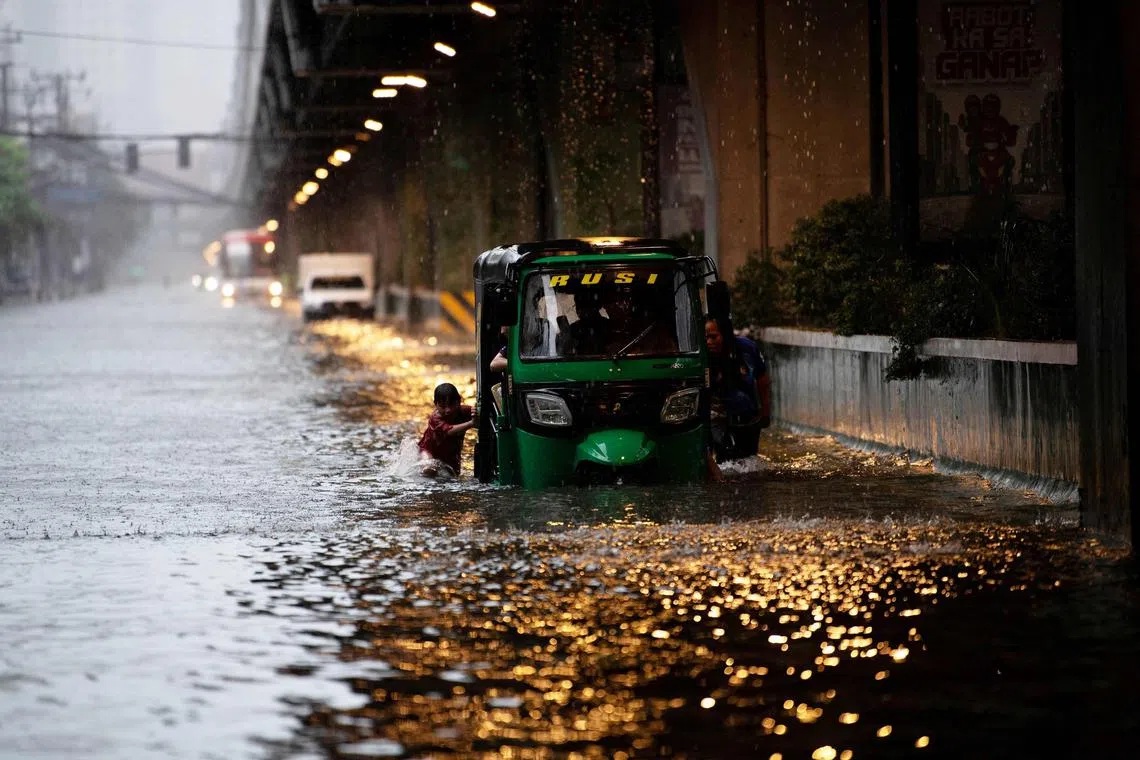Philippines flooding displaces thousands as new storm threatens
Sign up now: Get ST's newsletters delivered to your inbox

A boy helping to push a vehicle through a flooded street in Philippine capital Manila on July 22, after heavy rains caused floods.
PHOTO: AFP
Follow topic:
MANILA – Heavy flooding inundated the Philippines’ capital on July 22, forcing tens of thousands of people to flee, and schools and government offices to shut, while a fresh storm brewed off the coast.
At least six people have died, and another six remain missing after Tropical Storm Wipha skirted the country on July 18, according to the National Disaster Risk Reduction and Management Council.
Many neighbourhoods in Manila woke to find calf-deep pools of flood waters on July 22 after an overnight downpour swelled the Marikina River.
More than 23,000 people living along the riverbank were evacuated from their homes overnight, and moved to schools, village halls and covered courtyards.
About 47,000 more were evacuated from across the capital’s Quezon, Pasig and Caloocan areas, as well as from the main government district.
“Usually, these people are from low-lying areas like beside creeks,” said Mr Wilmer Tan, of the Marikina rescue office, who said the river reached 18m in height.
An elderly woman and her driver were swept down a swollen creek as they attempted to cross a bridge in Caloocan, said Mr John Paul Nietes, an emergency operations centre assistant supervisor.
It was initially hoped that the pair had escaped after the car was recovered with a broken window.
But Caloocan Mayor Dale Gonzalo Malapitan announced one of the bodies had been found.
“We’ve found (the driver),” he told Manila radio station DZMM. “The body was recovered 4.5km from where the vehicle was swept away... They were unable to bail out.”
No respite
As flood waters began receding in Manila by the afternoon of July 22, the national weather service said a low-pressure area off the country’s east coast had developed into a tropical depression.
While not expected to make landfall, the depression would bring continued heavy rain until the end of the week, the agency said.
Thousands of people, meanwhile, remained unable to return to their homes.
AFP journalists in Cainta, a small town on the outskirts of the capital, saw residents using styrofoam boxes and abandoned refrigerators as makeshift flotation devices to navigate the flood waters.
Mr Angelo Dela Cruz, 18, employed a rubber boat – one purchased in anticipation of frequent flooding – to transport rice for his aunt’s small eatery.
“Instead of using the van, we have to use the boat and push it while we wade through the flood to prevent the rice from getting wet,” he said.
At least 20 storms or typhoons strike or come near the Philippines each year, with the country’s poorest regions typically the hardest hit.
Deadly and destructive storms are becoming more powerful as the world gets warmer
“This is hard because, if the rain (continues), the river will swell,” Manila street sweeper Avelina Lumangtad, 61, said, as she stood next to a flooded thoroughfare. “The floods are dangerous.” AFP

